More downwards movement was expected as most likely for this week. The target at 63.60 was met and so far has been slightly passed.
Summary: The larger trend for Oil is up. Pullbacks offer opportunities to join the trend.
The current pullback may be complete here or very soon. A breach of the green best fit channel on the daily chart by a full daily candlestick above and not touching the trend line, preferably with clear and strong upwards movement, would add confidence that a low is in place.
The target is either at 78.47 to 80.63, or 104.08 to 106.25. The second target zone is preferred.
Risk to long positions here is at 55.24.
New updates to this analysis are in bold.
MAIN WAVE COUNT
MONTHLY CHART
The bear market for US Oil looks to be over and a new bull market looks to be in its early stages. The prior bearish wave count has been invalidated, leaving only this very bullish wave count.
A huge zigzag down to the last low may be complete and is labelled here Super Cycle wave (II).
Cycle wave b must be seen as complete in August 2013 for this wave count to work. It cannot be seen as complete at the prior major swing high in May 2011.
Cycle wave b is seen as a zigzag, and within it primary wave B is seen as a running contracting triangle. These are fairly common structures, although nine wave triangles are uncommon. All subdivisions fit.
Primary wave C moves beyond the end of primary wave A, so it avoids a truncation. But it does not have to move above the price territory of primary wave B to avoid a truncation, which is an important distinction.
If cycle wave b begins there, then cycle wave c may be seen as a complete five wave impulse.
Super Cycle wave (III) must move beyond the end of Super Cycle wave (I). It must move far enough above that point to allow room for a subsequent Super Cycle wave (IV) to unfold and remain above Super Cycle wave (I) price territory.
Cycle wave I may be incomplete. It may be unfolding as an impulse and may have now moved through the middle portion. Commodities have a tendency to exhibit swift strong fifth waves, and this tendency is especially prevalent for third wave impulses. Intermediate wave (5) to end primary wave 3 may be very swift and strong, ending with a blow off top.
When cycle wave I is complete, then cycle wave II may be a deep correction that may not move beyond the start of cycle wave I below 26.06.
Data from FXCM for USOil does not go back to the beginning of Super Cycle wave (I). Without an accurate known length of Super Cycle wave (I) a target cannot be calculated for Super Cycle wave (III) to end using Fibonacci ratios. The target for Super Cycle wave (III) may be calculated when cycle waves I, II, III and IV within it are complete. That cannot be done for many years.
WEEKLY CHART
Intermediate wave (3) is now complete. There is no Fibonacci ratio between intermediate waves (1) and (3), and intermediate wave (3) is longer than 1.618 the length of intermediate wave (1).
This wave count fits with classic technical analysis at the monthly and daily chart levels.
Intermediate wave (2) was a deep double zigzag. Intermediate wave (4) may now be a complete combination. While combinations are labelled W-X-Y, the same as double zigzags, they are very different structures. Zigzags and multiple zigzags are a separate family of structures to combinations. Combinations belong in the sideways family of corrections, which includes triangles and flats. There is alternation in structure here between intermediate waves (2) and (4).
If intermediate wave (4) continues lower, then look for final support at the lower edge of the black trend channel. This channel sits slightly differently on this weekly chart to the daily chart below, because this weekly chart is on a semi log scale and the daily is arithmetic.
DAILY CHART
Intermediate wave (4) may be now a complete double combination.
The first structure in a double combination may be a complete zigzag labelled minor wave W. There is a little disproportion within minute wave a between the corrections of minuette waves (ii) and (iv), but this is slight enough to be acceptable for this market.
The double is joined by a complete three in the opposite direction, a zigzag labelled minor wave X. X waves within combinations have no minimum nor maximum allowable length, and may make new price extremes beyond the start of wave W as this one does. The only guideline in terms of depth for X waves is that they are normally very deep.
The second structure in a double combination would most likely be a flat correction as the two most common structures in a double combination are one zigzag and one flat.
Within the flat correction of minor wave Y, minute waves a and b both subdivide best as zigzags. This wave count has a good fit and the right look for these waves.
Minute wave c has moved below the end of minute wave a, avoiding a truncation. Minor wave Y has now reached down to about the same level as minor wave W. Minute wave c subdivides as a completed five wave impulse (subdivisions have been carefully checked on the hourly chart).
Price remains within the narrow best fit channel. A breach of this channel is required for confidence that a low is in place. The breach should be by a full green daily candlestick above and not touching the upper edge of the channel.
If a candlestick reversal pattern appears at the low, that would also offer confidence that a low is in place.
While price remains within the channel, it must be accepted that price may continue to fall. Look for first support at the lower edge of the black channel, which is copied over from the weekly chart. On this daily chart, which is on an arithmetic scale, the trend line is now close by.
TECHNICAL ANALYSIS
MONTHLY CHART

Click chart to enlarge. Chart courtesy of StockCharts.com.
The larger trend remains upwards.
With a long upper candlestick wick and support from volume, the last completed month of October is bearish. On its own, this is not an indication of the end of the upwards trend though; it is noted that August 2017 was similar yet price continued higher.
However, the month of October also completes a Bearish Engulfing candlestick pattern. This is a strong reversal pattern. This offers a warning that the Elliott wave count may be wrong. Members are advised to carefully manage risk if expecting price may continue upwards from here.
The resistance line on On Balance Volume is redrawn; it no longer held technical significance. Bullish divergence between price and On Balance Volume remains, and is still a strong technical indicator that price may continue upwards to make new highs.
WEEKLY CHART
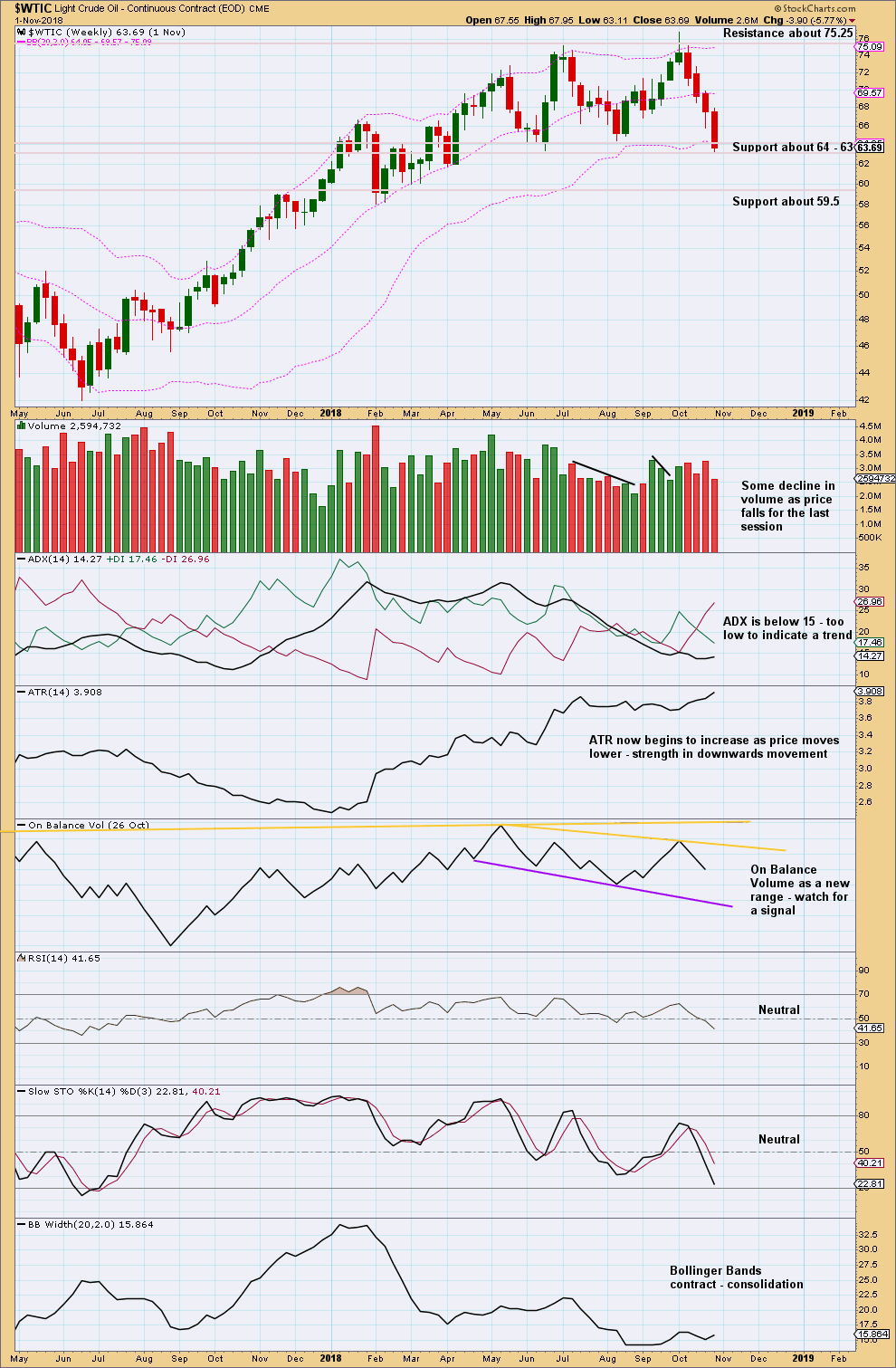
Click chart to enlarge. Chart courtesy of StockCharts.com.
It is upwards weeks during the consolidation that have strongest support from volume. This looks like a continuation pattern. The breakout would most likely be upwards.
Price is now at a strong zone of support. If it breaks below 63, then look for next support about 59.50. Stochastics is nearing oversold. There is a little room here for price to fall further.
DAILY CHART
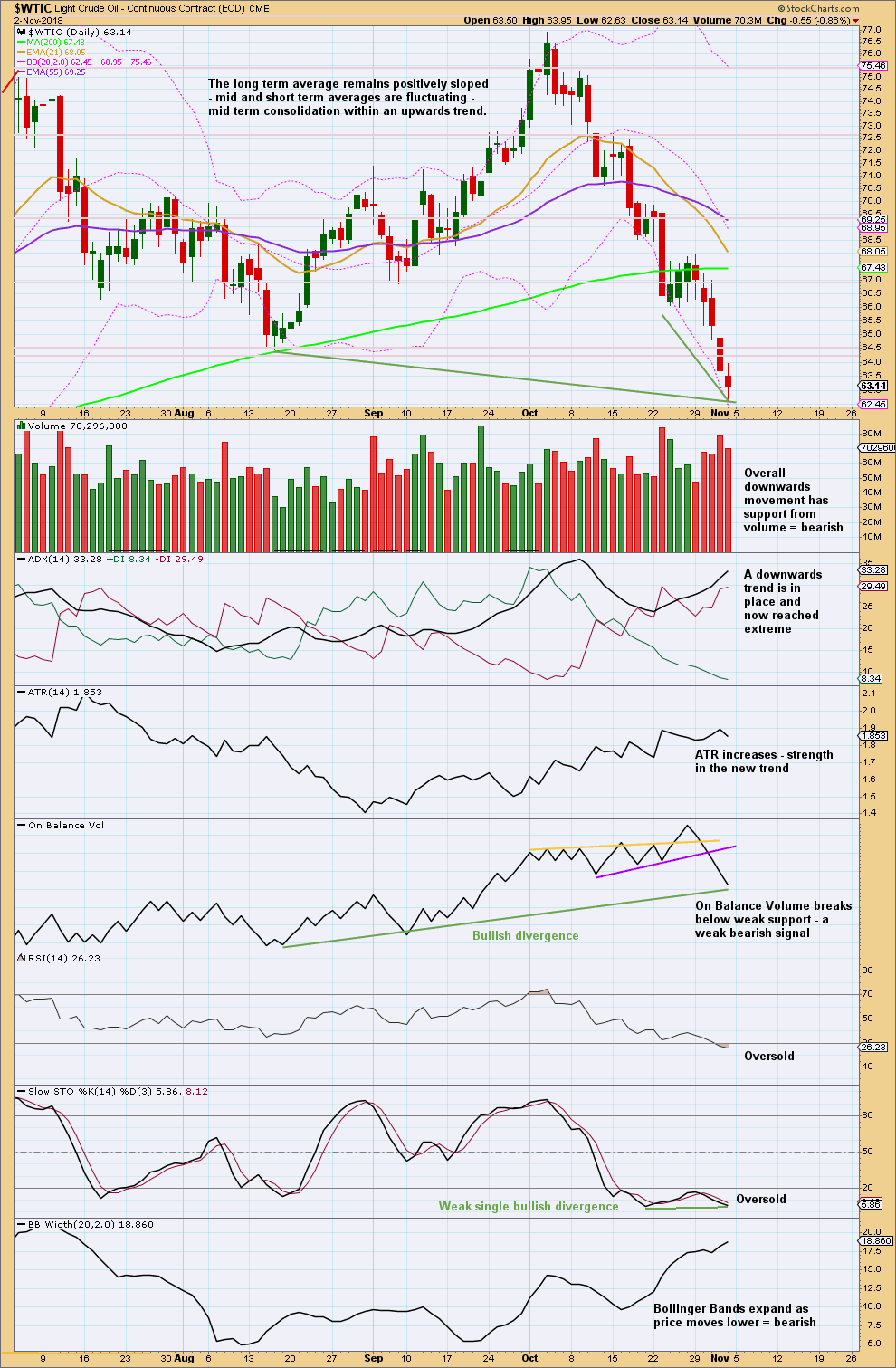
Click chart to enlarge. Chart courtesy of StockCharts.com.
RSI is now oversold and the trend is extreme. Look now for a reversal candlestick pattern to indicate a low in place. At this time, there is no reversal pattern. It is possible price may fall further before finding a low.
The signal from On Balance Volume is weak because the trend line had only two anchor points. Bullish divergence between price and On Balance Volume may be given more weight; this supports the Elliott wave count.
Published @ 05:07 p.m. EST on November 3, 2018.
—
Careful risk management protects your trading account(s).
Follow my two Golden Rules:
1. Always trade with stops.
2. Risk only 1-5% of equity on any one trade.

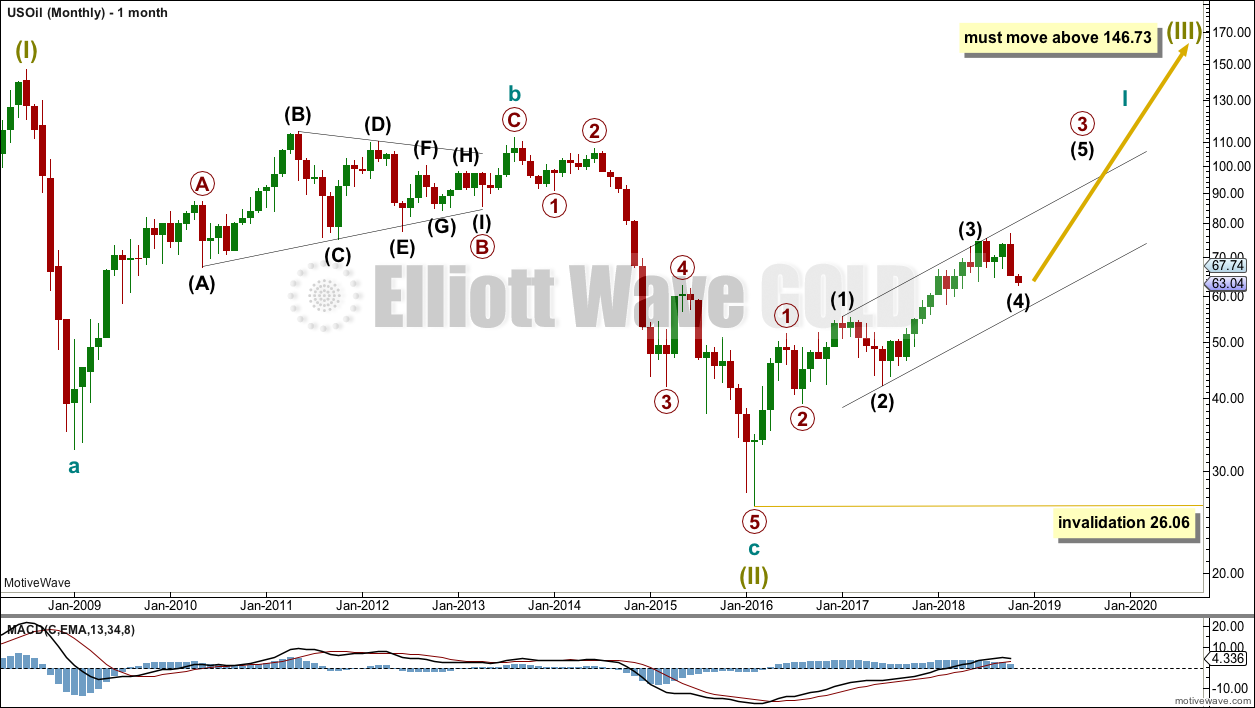
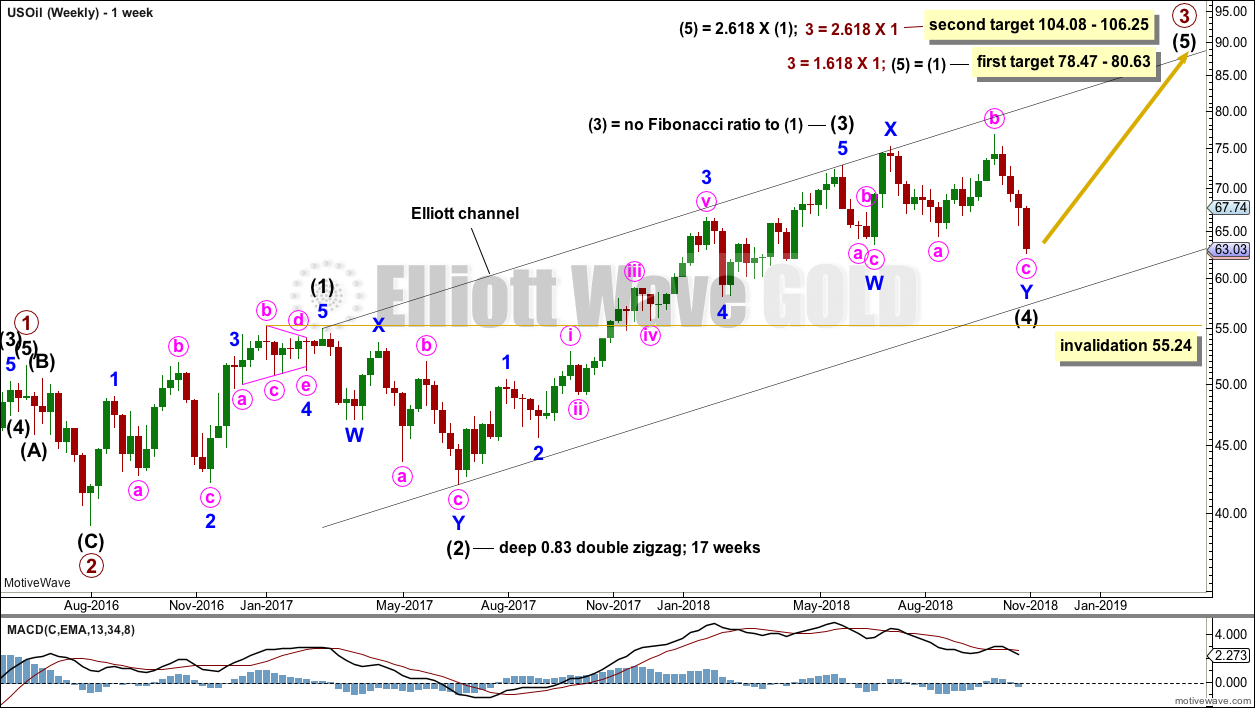
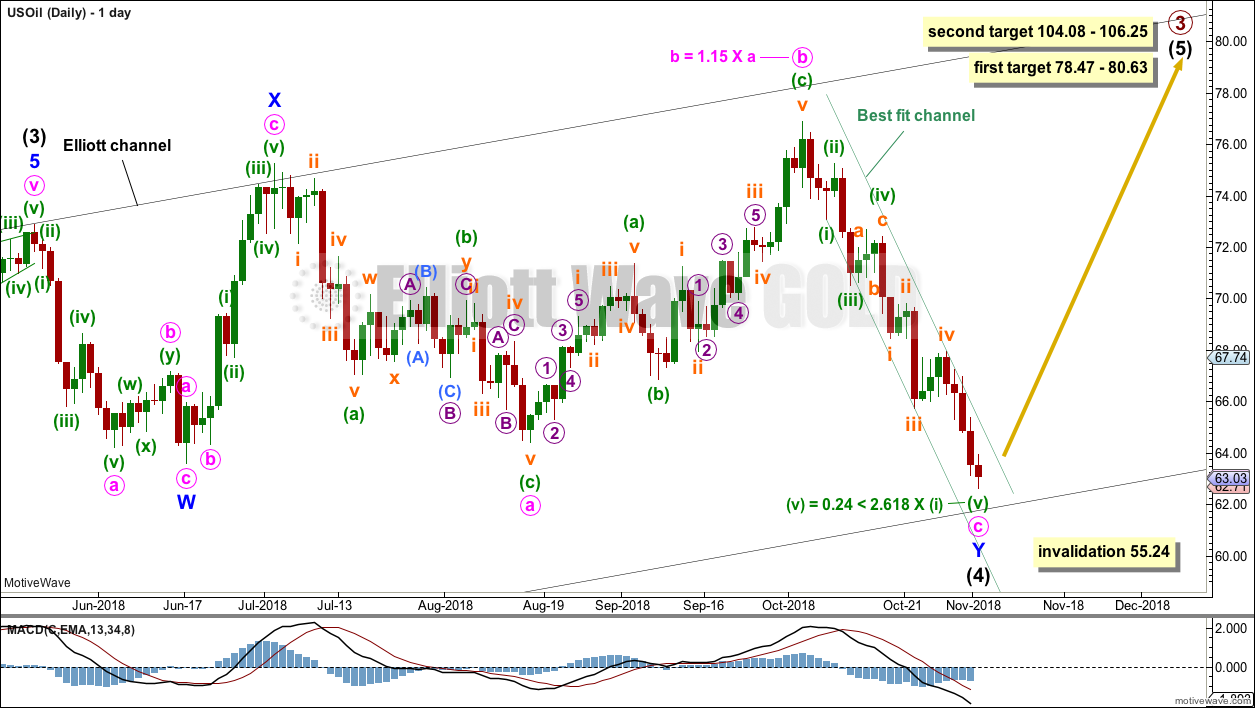
Oil is moving lower, there is still no reversal candlestick pattern and no breach of the green trend channel.
Today price is at the lower edge of the black channel when it is drawn on an arithmetic scale. When drawn on a semi-log scale there is still room here for price to fall further.
I’ll keep watching Oil daily and will post another updated daily chart if I see signs of a reversal.
For now, patience. Wait for a sign that a low is in place before entering long, that is a better approach to risk management. Any long positions entered already have risk still at 55.24.
When entering any position always reduce the size so that you are risking only 1-5% of equity on any one trade. Always use a stop!
Thanks for the update Lara.